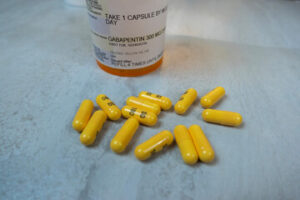By: Design for Change Recovery
Categories:
Is Gabapentin a Safe Alternative to Opioids?
You are here:As the opioid epidemic continues taking lives by the thousands, people who need painkillers are looking for safer alternatives. Many physicians now prescribe gabapentin as a substitute for highly addictive opioids such as Oxycontin.
Gabapentin were supposed to treat neuropathic pain without triggering potentially deadly addictions. But, it turns out, the drug is not as safe as doctors thought.
Gabapentinoids are less addictive than opioids and less likely to be fatal in large quantities. However, research suggests they may not be the solution doctors hoped for. Here’s what you need to know about this widely prescribed drug.
What Is Gabapentin?

Gabapentin (Neurontin) is an anticonvulsant and belongs to it’s own drug class, Gabapentinoids. Generally, it is prescribed to treat epilepsy, neuropathic pain, restless leg syndrome, and hot flashes.
This drug is similar in structure to gamma-aminobutyric acid (GABA). GABA is a brain chemical that affects the central nervous system.
The effects of gabapentinoids include relaxation and calmness. It reduces anxiety and can also help with sleep problems and nerve pain. These effects are what cause many people to use gabapentin for other conditions that it is not officially approved to treat.
Risks of Off-Label Use of Gabapentin
The magnitude of off-label use of gabapentin is shocking. Of almost 130 million prescriptions, 99% were for off-label uses. What does this mean? The most significant risk of off-label use is the risk of adverse interactions with other drugs the individual may be taking.
In addition to prescribing gabapentin for approved uses such as treating pain or seizures, it is now used for a range of ailments. Off-label use of gabapentinoids include using it to treat depression, anxiety, and other psychiatric disorders.
Many of the people who are prescribed the drug for off-label use are also taking other central nervous system depressants. Those may include:
- Antihistamines
- Muscle relaxants
- Antidepressants
- Anti-anxiety meds
Each of these drugs produces sedation and depressed breathing. Combining them with a gabapentinoid can increase the risk factors for life-threatening breathing problems.
Is Gabapentin Addictive?
When used as prescribed Gabapentin is considered safe, but it can be addictive when misused. The drug will produce euphoric effects in large doses, and people are increasingly using the drug to get high. Sadly, some people have used gabapentin in combination with other drugs to commit suicide.
People who rely on gabapentinoids for years for chronic pain relief often develop a tolerance or dependency. This means they need more of the drug to get the desired effects. If they attempt to stop taking the drug suddenly, they experience withdrawal symptoms. To escape the withdrawals, they take more of the drug.
Surprisingly, doctors often prescribe gabapentin along with opioids to enhance the pain-relieving effects. This practice has led to many fatal overdoses. For instance, research shows that many fatal opioid overdose victims also had been using gabapentin or its counterpart, pregabalin.
Patients who are taking gabapentinoids should avoid using it in combination with other drugs or alcohol. In some states, the drug has been reclassified as a Schedule V controlled substance and prescriptions must be reported to prescription drug monitoring databases.
Signs of Gabapentinoid Addiction
Like any other drug that is misused, gabapentinoids cause a person to display specific warning signs that indicate an addiction. The signs of excessive gabapentin use may include some or all of the following:
Physical signs:
- Poor coordination
- Mood changes
- Forgetfulness
- Agitation
- Speaking difficulties
- Drowsiness
- Dizziness
- Depression
- Thoughts of suicide
Behavioral signs:
- Exaggerating their symptoms to doctors
- Doctor-shopping or switching doctors
- Fear of running out of the drug
- Inability to quit despite consequences
- Changes in social habits or friends
If you know someone who is using gabapentinoids legally or illicitly, familiarize yourself with the warning signs of gabapentin addiction. Unfortunately, unlike opioids, there is no overdose-reversing medication available that can be administered in case of gabapentinoid overdose.
Treatment for Addiction at Design for Change Recovery
Quitting gabapentinoids without professional help can be risky. Withdrawal symptoms of varying severity can appear that require medical intervention. If you or a loved one is struggling with gabapentinoid addiction or other substance use disorders, contact Design for Change Recovery today.
At Design for Change, you’ll receive compassionate, skilled treatment in a nurturing environment. We are a state-certified and JCAHO accredited facility that assures you of getting the highest level of care available.
Design for Change provides a comprehensive, individualized treatment plan based on your specific circumstances and needs. We strive to help clients heal the physical, mental, and emotional damage caused by drug misuse or inappropriate use.
Learn more about how we can help you live a healthier, more fulfilling life. Call our Lancaster, CA facility today to get started.
Sources:
- theatlantic.com/ – Chronic Pain Is an Impossible Problem
- usnews.com/ – Many Psychiatric Patients are Getting Risky Drug Gabapentin ‘Off-Label’


